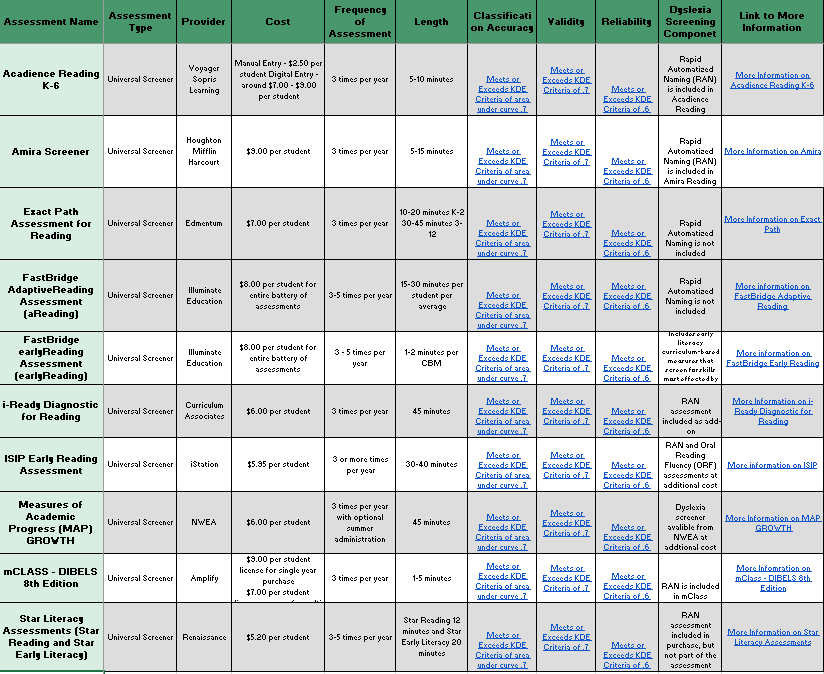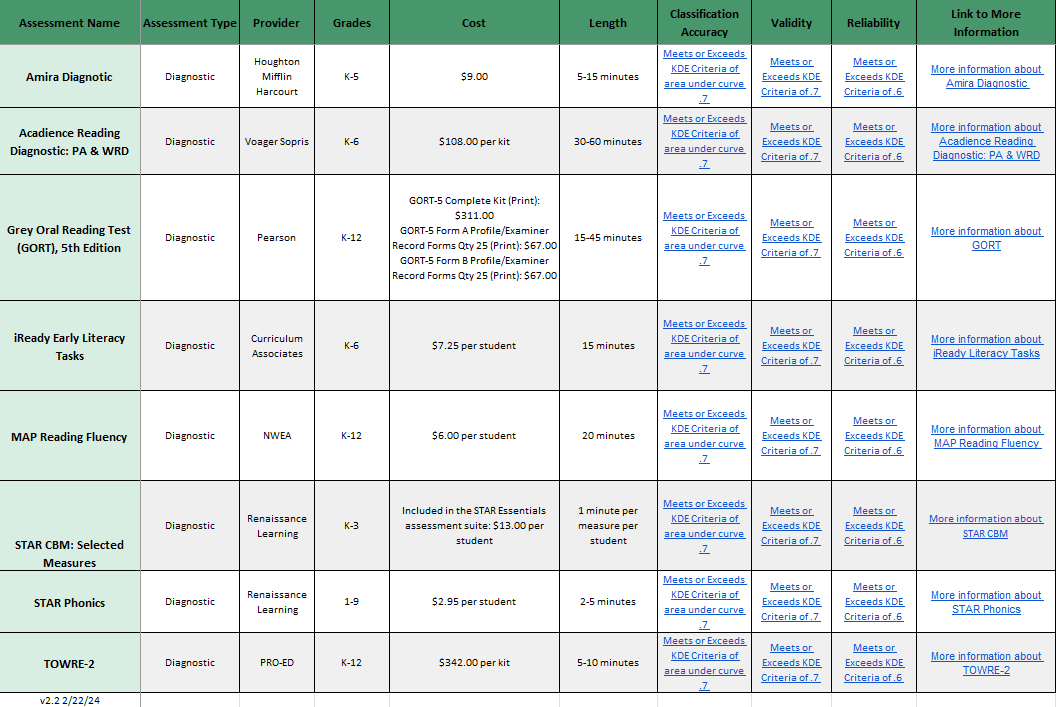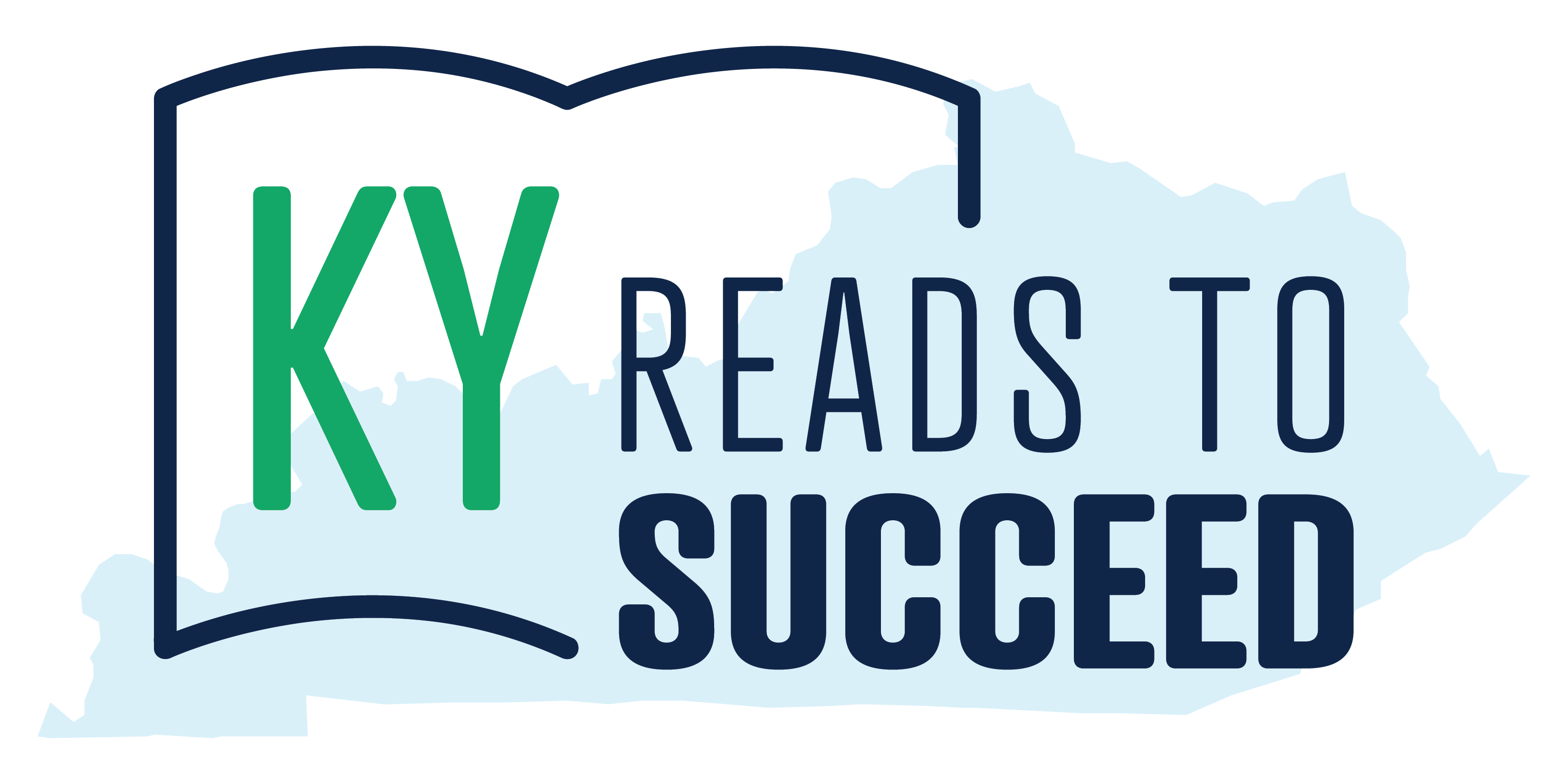Introduction
Per
Senate Bill 9 (2022), the Read to Succeed Act, by Jan. 1, 2023, each superintendent shall select:
- At least one reliable and valid universal screener for reading administered to all students in grades K-3; and
- At least one reliable and valid reading diagnostic assessment administered as part of a multi-tiered system of supports for students in grades K-3.
- All teachers of students in K-3 shall be trained on any reading diagnostic assessment and universal screener selected by the superintendent prior to administration of the assessment in the 2023-2024 school year.
Beginning with the 2023-2024 school year, a reliable and valid universal screener shall be:
- Given in the first 45 days of the school year for all kindergarten students; and
- Given in the first 30 days of the school year for grades 1-3.
- Based on the data from the above, a reading improvement plan shall be developed and implemented by a reading improvement team for any student in K-3 identified as needing accelerated interventions to progress toward proficient performance in reading.
The Senate Bill 9 Implementation Timeline document provides further guidance around what needs to be implemented when.
Early Literacy Assessments within KyMTSS
The Early Literacy Assessment within Kentucky's Multi-Tiered System of Supports (KyMTSS) document provides information around how universal screening and diagnostic assessment fit within a multi-tiered system of supports.
Valid and Reliable Early Literacy Screening Assessments
Approved Lists for Early Literacy Screening and Diagnostic Assessment Have Been Updated
The Kentucky Department of Education (KDE) recently reviewed early literacy screening and diagnostic assessment submissions for inclusion on the KDE approved lists, and updated lists are now available on the Early Literacy Screening Assessments webpage. KRS 158:305 requires each superintendent to select a universal screener and diagnostic assessment for reading that have been determined by the KDE to be reliable and valid to be administered as part of a multitiered system of supports for students in kindergarten through grade three.
The submission window for the 2024-2025 academic year is now closed. All complete submissions will undergo a review by the Early Literacy Technical Review Team as outlined in the Call for Early Literacy Screening and Diagnostic Assessment Submissions document. Newly approved universal screeners for reading and reading diagnostic assessments will be posted to the Early Literacy webpage by February 19, 2024. The next submission window will take place in November 2024.
Please contact Christie Biggerstaff, Director of Early Literacy, at christie.biggerstaff@education.ky.gov, with any questions.
Selection Criteria
The Kentucky Department of Education (KDE) established selection criteria to determine which assessments would be included on the final list of approved early literacy screening assessments.
Universal Screeners
Universal screening for early literacy provides an evidence-based and proactive way to monitor the effectiveness of Tier 1 reading instruction and to identify students who may be at risk for developing reading difficulties and in need of additional instruction or intervention. It is critical for educators to identify the potential for reading difficulties in the primary grades in order to provide support early and prevent failures from accumulating over time. Universal screening provides a standardized way to quickly, efficiently and reliably predict students who may be at risk for reading difficulties. Using validated screening procedures, the MTSS leadership team ensures that all students are screened with fidelity on an on-going basis, typically three times during the school year (i.e., fall, winter and spring).
Approved Universal Screeners Comparison Chart
It is suggested that districts begin their own selection process by reviewing the KDE Approved Universal Screeners Comparison Chart.

List of Approved Early Literacy Screening Assessments
Updated 3/6/24
*Note approval of an early literacy screening assessment is not an endorsement of the entire platform.
Dyslexia Screening
When school teams interpret universal screening results, they should keep in mind that reading diagnostic assessments have components targeting decoding difficulties that also include components such as oral language comprehension difficulties. A child may have more than one of these issues, but when considering dyslexia, it is decoding difficulties that are most prevalent. If a child has poor decoding ability (determined by universal screener or teacher or parent observation), it is useful to further assess for the following decoding sub processes:
These essentially are the components taught through Phonemic Awareness and Phonics instruction, two of the “Five Pillars of Reading” that make up a standard early reading curriculum (the other three being fluency, vocabulary and comprehension; National Reading Panel, 2001). Dyslexia screener information has been provided in the KDE Approved Universal Screeners Comparison Chart.
Diagnostic Assessments
Diagnostic Assessment
Diagnostic assessments for reading are used to provide more in-depth information of an individual student’s specific skills. Diagnostic assessments help teachers identify the skill deficits to effectively guide the next steps for instruction and intervention. Not all students need this type of in-depth reading assessment, but diagnostic data is most important for struggling and at-risk readers.
An example of an appropriate use of a diagnostic instrument would be to discover which components of reading are impaired in a child who has performed below grade level on a universal screening assessment. In this case, it would be useful to know if the child is impaired in reading fluency or accuracy, knowledge of word meanings, general background knowledge, or use of efficient comprehension strategies.
Diagnostic assessments can be formal standardized tests or informal measures such as criterion-referenced tests and informal reading inventories. When used for the purpose of identifying students in need of intervention, formal and informal diagnostic assessments should be valid and reliable.
Formal diagnostic assessments (like the ones included on the approved Early Literacy Diagnostic List) below provide information about the relative level of skill across the essential components of reading: phonemic awareness, phonics, fluency, vocabulary and comprehension.
Informal diagnostic assessments are typically obtained through administration of an informal reading inventory or a classroom or curriculum-based assessment. They give information at a very specific level (i.e., which letter/sound correspondences are known fluently).
The formal diagnostic assessments on the approved Early Literacy Diagnostic List have technical manuals that provide the evidence basis for how the assessments meet the criteria for classification accuracy, validity and reliability. Informal diagnostics may not have technical manuals in which validity and reliability data can be obtained.
Approved Diagnostics Comparison Chart
It is suggested that districts begin their own selection process by reviewing the KDE Approved Diagnostics Comparison Chart.

List of Approved Early Literacy Diagnostics
Progress Monitoring
Progress monitoring measures are brief, repeated measures that capture students' progress or rate of improvement over time in response to instruction or intervention using valid and reliable measures (Center on Multi-Tiered System of Supports, 2021). The data provides information on whether the student is making adequate progress with the current level of support. Progress monitoring requires repeated assessment with more frequent assessment when challenges are more intense. Data is collected and graphed regularly so student progress can be compared to a goal set using the standardized decision-making process. The frequency of progress monitoring should be matched to the intensity of the instruction. For example, progress monitoring at Tier 2 is typically every two weeks or at least monthly for students identified for academic intervention and supports, and at least weekly for students identified for more intensive intervention at Tier 3.
Disclosure Statement
Reference in this website to any specific commercial products, processes, or services, or the use of any trade, firm, or corporation name is for the information and convenience of the public, and does not constitute endorsement or recommendation by the Kentucky Department of Education (KDE). The KDE is not responsible for and does not in any way guarantee the accuracy of information in other sites accessible through links herein. KDE may supplement this with other services and products that meet the specified criteria.
Questions?
Please reach out to Christie Biggerstaff at christie.biggerstaff@education.ky.gov with any questions.
